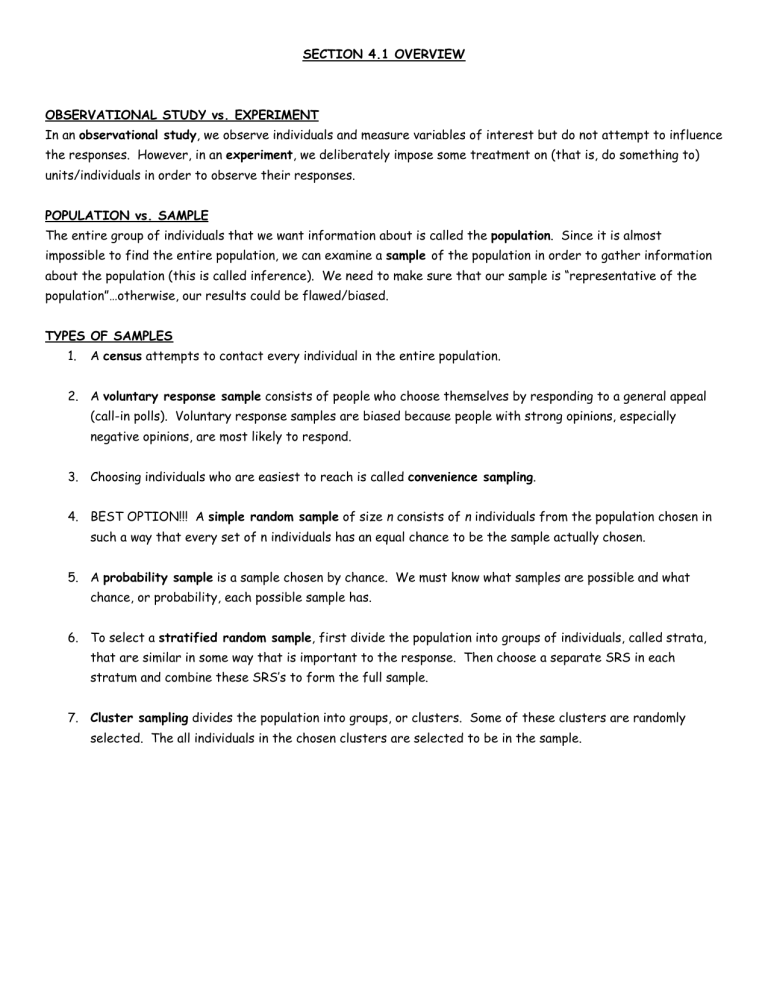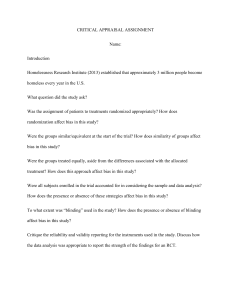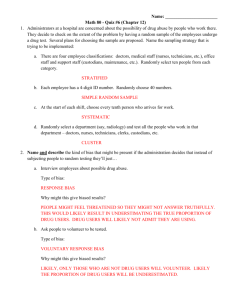
SECTION 4.1 OVERVIEW OBSERVATIONAL STUDY vs. EXPERIMENT In an observational study, we observe individuals and measure variables of interest but do not attempt to influence the responses. However, in an experiment, we deliberately impose some treatment on (that is, do something to) units/individuals in order to observe their responses. POPULATION vs. SAMPLE The entire group of individuals that we want information about is called the population. Since it is almost impossible to find the entire population, we can examine a sample of the population in order to gather information about the population (this is called inference). We need to make sure that our sample is “representative of the population”…otherwise, our results could be flawed/biased. TYPES OF SAMPLES 1. A census attempts to contact every individual in the entire population. 2. A voluntary response sample consists of people who choose themselves by responding to a general appeal (call-in polls). Voluntary response samples are biased because people with strong opinions, especially negative opinions, are most likely to respond. 3. Choosing individuals who are easiest to reach is called convenience sampling. 4. BEST OPTION!!! A simple random sample of size n consists of n individuals from the population chosen in such a way that every set of n individuals has an equal chance to be the sample actually chosen. 5. A probability sample is a sample chosen by chance. We must know what samples are possible and what chance, or probability, each possible sample has. 6. To select a stratified random sample, first divide the population into groups of individuals, called strata, that are similar in some way that is important to the response. Then choose a separate SRS in each stratum and combine these SRS’s to form the full sample. 7. Cluster sampling divides the population into groups, or clusters. Some of these clusters are randomly selected. The all individuals in the chosen clusters are selected to be in the sample. *Bias is present if a sampling method systematically favors certain outcomes. TYPES OF BIAS 1. Undercoverage occurs when some members of the population are inadequately represented in the sample. A classic example of undercoverage is the Literary Digest voter survey, which predicted that Alfred Landon would beat Franklin Roosevelt in the 1936 presidential election. The survey sample suffered from undercoverage of low-income voters, who tended to be Democrats. 2. Sometimes, individuals chosen for the sample are unwilling or unable to participate in the survey. Nonresponse bias is the bias that results when respondents differ in meaningful ways from nonrespondents. 3. Response bias refers to the bias that results from problems in the measurement process. Some examples of response bias are given below. a. Leading questions. The wording of the question may be loaded in some way to unduly favor one response over another. b. Social desirability. Most people like to present themselves in a favorable light, so they will be reluctant to admit to unsavory attitudes or illegal activities in a survey, particularly if survey results are not confidential. c. Voluntary response bias occurs when sample members are self-selected volunteers, as in voluntary samples. An example would be call-in radio shows that solicit audience participation in surveys on controversial topics (abortion, affirmative action, gun control, etc.). The resulting sample tends to over-represent individuals who have strong opinions. SECTION 4.2 OVERVIEW BASIC VOCABULARY FOR EXPERIMENTS The individuals on which the experiment is done are the experimental units. When the units are human beings, they are called subjects. A specific experimental condition applied to the units is called a treatment. THREE BASIC PRINCIPLES OF EXPERIMENTAL DESIGN Control (not control group) refers to the overall effort to minimize variability in the way the experimental units are obtained and treated (minimizes confounding/lurking variables). Replication: The idea of replication is to use enough subjects in each group, to reduce chance variation (you can’t ever eliminate chance variation). Also, this type of replication isn’t what you think…I think of replication as replicating the experiment (different place, different subject, different testers). That is also called replication but not the same replication as mentioned initially. Randomization: Either random selection or random assignment--you must use chance (randomization) to select your subjects and/or divide your subject into groups. TYPES OF EXPERIMENTS BEST OPTION!!!! A completely randomized comparative experiment is probably the simplest experimental design, in terms of data analysis and convenience. With this design, subjects are randomly assigned to treatments. With a randomized block design, the experimenter divides subjects into subgroups called blocks, such that the variability within blocks is less than the variability between blocks. Then, subjects within each block are randomly assigned to treatment conditions. Compared to a completely randomized design, this design reduces variability within treatment conditions and potential confounding, producing a better estimate of treatment effects. A matched pairs design is a special case of a randomized block design. It can be used when the experiment has only two treatment conditions; and subjects can be grouped into pairs, based on some blocking variable. Then, within each pair, subjects are randomly assigned to different treatments. SOME SPECIFICS ABOUT EXPERIMENTS Double Blind Experiment: When neither the subjects nor those who measure the response variable know which treatment a subject received. Placebo Effect: A term that doctors use to describe the phenomenon where patients get better because they expect the treatment to work even though they have taken a fake pill.



